As you might expect, locals referred to knives made by BOTH families as “Sabatier knives.” Other knife producers began calling their knives Sabatier to profit from the free press. As a result, numerous separate knife producers use the same name. Worse, they utilized the same trademark.
Trademark law later addressed this shambles. However, the businesses had all been created before the statute was passed. To differentiate themselves, the French government eventually decreed that all of the enterprises had to add a sign, letter, or word after the Sabatier mark.
As of this writing, over 31 companies utilize the Sabatier logo in conjunction with another identification as their principal brand identity. This implies that if you come across a Deglon Sabatier knife, you should check into Deglon Sabatier knife reviews to learn more.
So, how effective are Sabatier knives?
The response, as one might assume, is “it depends.” While there are a few excellent Sabatier brands (such as K Sabatier and Four Star Elephant Theirs Issard), there are several that are not quite as nice. Here are some of the top Sabatier knives and knife sets available today.
Best Sabatier Knives Review – Editor’s Recommended
1. Sabatier Forged Chef’s Knife

To begin, let’s take a look at a standard French chef’s knife by K Sabatier. This is a low-cost kitchen workhorse that is distinct enough from a traditional German or Japanese-style knife to be worth adding to your collection.
Let’s start with stylistic contrasts
French-style knives (such as this one) are thinner, shorter, and pointier than German-style knives. The blade has less curve (or “belly”) and there is less metal in between your knuckles and the cutting board while you chop. The smaller, lighter blade, on the other hand, provides for a nimble, fast-feeling knife. Because of the increased precision and quickness, many professional chefs choose French knives like this one over German knives. kitchen utensil container, kitchen utensil storage ideas
Steel is the next key topic to cover. This knife is composed of the high-carbon stainless steel combination Z50C13. It has an HRC of around 55, indicating that it is rather soft and easy to sharpen. To keep this knife sharp, go with a more conservative edge profile and use honing steel frequently. The advantage is that you can sharpen it with almost any instrument, and there is very little risk of accidentally chipping your blade.
Furthermore, the stainless steel used in this knife will not tarnish or corrode readily. This is especially helpful when working with acidic foods. High-carbon blades are fantastic for cutting relatively inert foods, but when working with something more corrosive, your blade may develop a patina or a horrible corroded patch that will make your knife look unsightly. While you can often remove a patina with the correct tools and a lot of effort, it’s not something you want to deal with regularly. In other words, using stainless steel rather than high-carbon steel in your high-end knives makes them much easier to work with regularly.
Despite these characteristics, the balance and “feel” of this knife will stand out. I noted before that French knives are particularly light in the hand, and this knife is a prime illustration of that. It is, indeed, one of the most agreeable knives made. These options are not free. Fortunately, they are also reasonably priced. While this 6′′ knife is on the shorter side, it is also on the less expensive side. It is one of the most reasonably priced high-end chef’s knives on the market. This means it has my unqualified approval.
If you like to cut with a rocking motion, use this in conjunction with a more typical German chef’s knife. Otherwise, you should have no trouble utilizing this as your primary cutting tool, an extra knife for smaller food preparation tasks, or anything in between.
2. Sabatier Stainless Steel Kitchen Knife Set
Look at this knife block for an excellent example of a Sabatier brand that is not nearly as nice. It is a complete set of “high-carbon stainless” steel knives in a cheap-looking hardwood block. While it is not a bad deal for the price, it’s not nearly as good as the K Sabatier knife mentioned above.
To be honest, the presentation is the most problematic aspect. This is a set of European knives made of softer steel, which means they will “dull” quickly. However, because the metal is soft, repairing this problem using honing steel or a sharpening kit is almost straightforward. In other words, if you want to keep these blades sharp, you must maintain them regularly.
The other concern is rusting. This low-cost knife set draws purchasers from all occupations, including those who do not know how to clean their blades correctly. Stainless steel signifies “less” staining, not “never.” In other words, if you leave these blades in a wet sink, they will corrode, discolour, and/or rust. If you want them to last, you must immediately dry them after washing them.
To be fair to Sabatier, these difficulties are not specific to this knife set. The issue is how this set is created, promoted, and presented. It’s not fancy or high-quality enough to appeal to serious cooks, and the strain of caring for these overly expensive knives is too much for many home cooks. Instead, Sabatier has created a product for an awkward valley between two potential audiences.
Honestly, I doubt it. For the same price, you may get a Ginsu Chikara set that is intended for use by inexperienced cooks. You could also spend a little extra and obtain a Cangshan or Dalstrong set without the steak knives. These more expensive blades will maintain their edges better and have greater balance, aesthetics, and overall design.
However, the main truth is that this is a functional, serviceable knife block. If you’re prepared to put in the effort to maintain these knives, they’ll serve you well in the kitchen. These edges will stay sharp and perfect however long you comprehend how to clean and focus on them.
This isn’t my favourite knife set on the market, but it’s an adequate substitute.
3. Sabatier Stainless Steel High-Carbon Paring Knife
It should come as no surprise that this Sabatier is from a different manufacturer than the Sabatier knives reviewed previously. This paring knife, like the K Sabatier at the top of the page, features a high-carbon stainless steel blade (made from X50CrMoV15 this time, which is a couple of points harder on the HRC scale). The Sabatier emblem, unlike the other knife, has a distinct animal next to it.
As previously stated, the knife is composed of a slightly tougher metal. It is of course important to look at how it affects and maintains the knife’s edge. The steel utilized in this knife may reach 58 HRC, which is the maximum that some types of whetstones can sharpen. Guarantee you know the limits of any upkeep hardware you own or need to buy.
To be clear, I believe that harder knives are generally superior. By increasing the HRC by one point, you will have to sharpen your knife half as often. This means that the soft French chef’s knife at the top of the page takes far less maintenance from your honing steel. It’ll also keep a sharper edge in general, making it a better pick if you know you’re going to reprofile your knife to a killer angle.
In terms of artisanship, this knife has a nice balance and a stylish, gorgeous hardwood handle. On its alone, it’s an excellent addition to almost any knife block. This olivewood paring knife is an excellent alternative if you want a lightweight paring knife from one of the various Sabatier brands. Look at the other items from this organization. A 6′′ fillet knife, for example, is slightly thinner than a French K Sabatier chef’s knife but not wholly dissimilar. If you know you want tougher steel, this is an alternative option.
4. Sabatier French-style Chef Knife
This full-sized French-style chef’s knife bears the same Sabatier imprint as the knife mentioned above. It has the same X50CrMoV15 steel, olivewood handle, and overall high-quality build. So what is the deal with it not being at the top of the page?
The answer is simple: this knife is quite expensive. Consult the rest of this company’s products. Even on sale, it is more expensive than the K Sabatier I suggested. While you get an extra 2 inches of the knife, I am not sure that is a good thing. I prefer to use my French knives for little chores rather than larger ones. If I require a whole 8 inches, I will use a German or Japanese-style knife.
Nonetheless, this knife is a fantastic value in general. It is not pricey for the quality it provides. Instead, the K Sabatier is astonishingly inexpensive. If you prefer harder metal, longer blades, or finer wooden handles, this Sabatier is a wonderful choice. A lovely, functional knife will serve you well in the kitchen.
5. Sabatier Self-Sharpening Edgekeeper Pro Knife Set
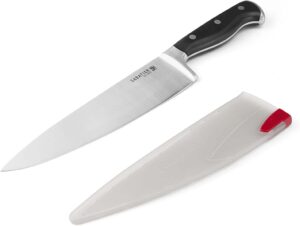
This set, made by the same Sabatier as the knife block discussed above, has the unusual feature of putting a knife sharpener in each hole in the knife block. Ceramic rods automatically align the edge of the knife when it is stored, ensuring that it remains sharp indefinitely.
At least, that is what you may believe. If you are experienced with knife sharpening, you will recognize that this isn’t a one-stop shop. The ceramic rods are high grit to prevent overzealous owners from practically sharpening their blades to oblivion. This means you are honing or stropping the blades instead of sharpening them.
So, does this help you keep your knives sharp?
Yes.
It is effective at keeping your knives sharp. The word “keeping” is in question here. If you ruin the edge (either through a short period of misuse or a lengthy period of typical use), the fine-grit ceramic rods will be useless. You need to use another tool to fix the edge of your knife.
This method is ideal for multiple users. Sharpening a decent knife is rarely necessary. Even when working with softer steel, the majority of your work is done with a honing steel or a strop. This knife block eliminates the need for weekly (or even daily) sharpening sessions by doing the grunt work for you. All that remains is the occasional (yearly at most) manual sharpening to keep everything in pristine condition.
However, this knife set is not without problems. The most significant is that the block itself is not visually pleasing. It’s a strange matte-painted wood that doesn’t look good on a counter. This is sad because knife blocks are a lovely visual complement to a kitchen counter.
If you want a reasonably priced set of non-serrated European-style knives, this isn’t the worst option. The integrated edge care mechanism makes it easier to maintain this knife set sharp. Most importantly, you are not paying a premium for the additional capabilities. Instead, you’ll have to put up with an unsightly knife block.
Sabatier Knives: The Best French Knife Brand?
While certain Sabatier imprints produce great knives that you should be glad to display, others produce fairly poor knife sets that are nonetheless reasonably priced. Whatever you’re looking for, do some additional research to ensure that the flavour of Sabatier you’re considering is the correct brand. You would rather not get some unacceptable sort of knife unintentionally.

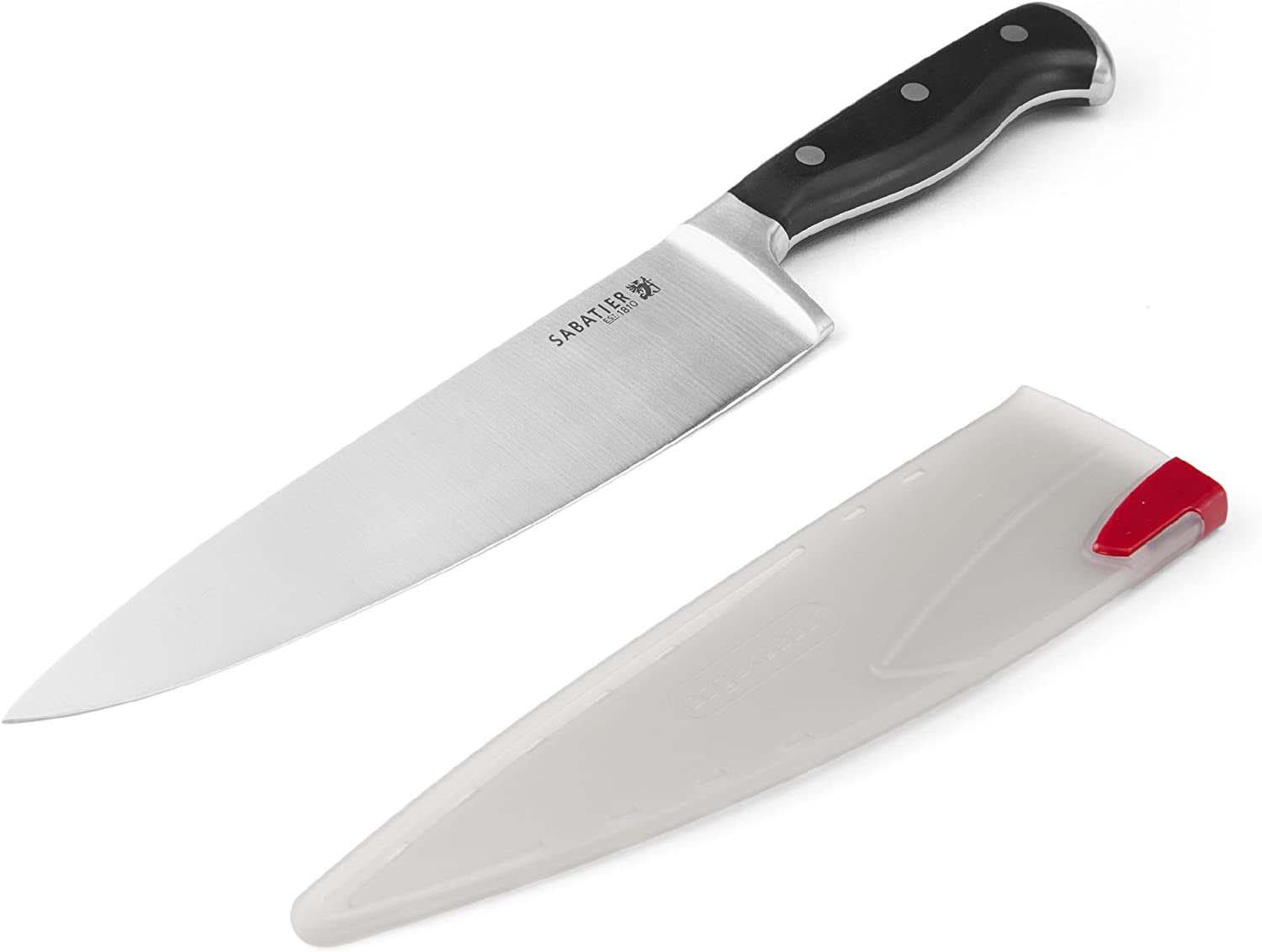
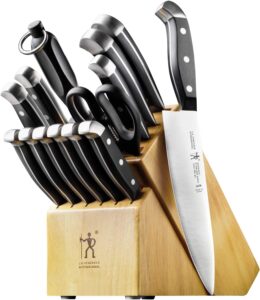
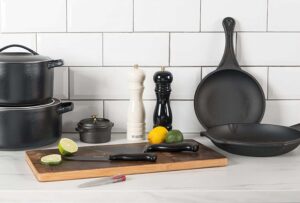
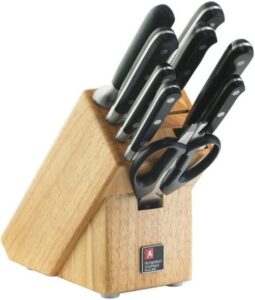
Thanks for providing the information and saving time.
Thank you so much for providing information about the home & kitchen products on this site.